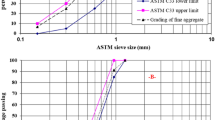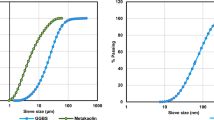Abstract
In the last few decades, research into nanomaterials' role in improving building materials' performance has grown and produced excellent results. As a chemical element, SiO2 is observed in many building materials, such as ceramics, glass, sand, cement, pastes, and binders. In the building materials category, standard lime-based pastes for roofs and screeds (LRP) are used as building insulation materials (BIMS). LRP is a complicated multilayer system composed of various binders and ingredients. This study investigated the effect of various percentages of nanosilica (NS) replacement from 0 to 2.5% by the weight of the LRP. The specimens were demolded after 48 h, and 75% of the total samples were separated and treated for 7 h at different heat temperatures (T) of 40, 60, and 80 °C. After heat treatment, all samples were cured at room temperature (T = 25 °C) for 3, 7, and 28 days. The XRF and EDX analysis indicated that the LRP consisted of SiO2 and CaO, which primarily transformed into calcium silicate and calcium carbonate throughout the hydration processes. The increase in compressive strength indicated that the addition of NS played an important role in forming calcium silicate during hydration and reduced pore structures. In addition, the highest compressive strength results were obtained at T = 40 °C. Thermogravimetric (TGA) analysis showed that the sample with 2.5% NS had a weight loss of 2.3 times less than the sample without NS content. Based on the compressive strength and acceptable flowability, the optimal percentages of NS content replaced with LRP at the water/binder ratios (w/b) of 60% and 75% were obtained to be 1.5% and 2.5%, respectively. In terms of modeling criteria, the full quadratic model was the most accurate model to predict the compressive strength as a function of w/b, T, curing age (t), and NS (%), of LRP, with a higher coefficient of determination (R2) and lower root mean square error (RMSE).

















Similar content being viewed by others
Data Availability
The data supporting the conclusions of this article are included in the article.
References
E.K. Akpinar, F. Koçyigit, Thermal and mechanical properties of lightweight concretes produced with pumice and tragacanth. J. Adhes. Sci. Technol.Adhes. Sci. Technol. 30(5), 534–553 (2016)
A.N. Al Qadi, K.N.B. Mustapha, H. Al-Mattarneh, Q.N. Al-Kadi, Statistical models for hardened properties of self-compacting concrete. Am. J. Eng. Appl. Sci. 2(4), 764–770 (2009)
F. Anderegg, Strength of glass fires. Ind. Eng. Chem. 31(3), 290–298 (1939)
S. Aydın, B. Baradan, Effect of pumice and fly ash incorporation on high temperature resistance of cement based mortars. Cem. Concr. Res.Concr. Res. 37(6), 988–995 (2007)
P. Balaguru, K. Chong, Nanotechnology and concrete: research opportunities. In: Proceedings of the ACI Session on Nanotechnology of Concrete: Recent Developments and Future Perspectives, pp. 15–28 (2006).
K. Baltakys, R. Jauberthie, R. Siauciunas, R. Kaminskas, Influence of modification of SiO2 on the formation of calcium silicate hydrate. Mater. Sci. Pol. 25(3), 663–670 (2007)
B. Balun, M. Karataş, Influence of curing conditions on pumice-based alkali activated composites incorporating Portland cement. J. Build. Eng. 43, 102605 (2021)
A. Bouchair, Steady state theoretical model of fired clay hollow bricks for enhanced external wall thermal insulation. Build. Environ. 43(10), 1603–1618 (2008)
D. Bowen, Fibre-reinforced ceramics. Fibre Sci. Technol. 1(2), 85–112 (1968)
Y. Cai, P. Hou, X. Cheng, P. Du, Z. Ye, The effects of nanoSiO2 on the properties of fresh and hardened cement-based materials through its dispersion with silica fume. Constr. Build. Mater. 148, 770–780 (2017)
H.S. Chouhan, P. Kalla, R. Nagar, P.K. Gautam, A.N. Arora, Investigating use of dimensional limestone slurry waste as fine aggregate in mortar. Environ. Dev. Sustain. 22(3), 2223–2245 (2020)
T.F. Cooke, Inorganic fibers—a literature review. J. Am. Ceram. Soc. 74(12), 2959–2978 (1991)
H.A. Dahish, M. Bakri, M.S. Alfawzan, Predicting the strength of cement mortars containing natural pozzolan and silica fume using multivariate regression analysis. GEOMATE J. 20(82), 68–76 (2021)
R. Dylewski, J. Adamczyk, The comparison of thermal insulation types of plaster with cement plaster. J. Clean. Prod. 83, 256–262 (2014)
R.A. e Silva, P. de CastroGuetti, M.S. da Luz, F. Rouxinol, R.V. Gelamo, Enhanced properties of cement mortars with multilayer graphene nanoparticles. Constr. Build. Mater. 149, 378–385 (2017)
O.W. Flörke, H.A. Graetsch, F. Brunk, L. Benda, S. Paschen, H.E. Bergna, W.O. Roberts, W.A. Welsh, C. Libanati, M. Ettlinger, Silica. Ullmann’s Encyclopedia of Industrial Chemistry (Wiley, New York, 2000)
S. Iliopoulos, L. De Smet, D. Aggelis, Investigating ultrasonic wave dispersion and attenuation in fresh cementitious materials: A combined numerical, analytical, and experimental approach. NDT E Int. 100, 115–123 (2018)
P.E. Imoisili, K.O. Ukoba, T.-C. Jen, Green technology extraction and characterisation of silica nanoparticles from palm kernel shell ash via sol–gel. J. Market. Res. 9(1), 307–313 (2020)
A.G. Kasikov, E.A. Shchelokova, A.M. Dvornikova, Recovery of rhenium from sulfuric acid solution by TOPO-impregnated silica sorbents. Sep. Sci. Technol. 56(2), 242–251 (2021)
A. Kılıç, Z. Sertabipoğlu, Effect of heat treatment on pozzolanic activity of volcanic pumice used as cementitious material. Cement Concr. Compos.Concr. Compos. 57, 128–132 (2015)
A. Kouakou, C. Legrand, E. Wirquin, Measurement of apparent activation energy of cements in mortars by means of Langavant’s semi-adiabatic calorimeter. Mater. Struct. 29(191), 444–447 (1996)
M.S. Konsta-Gdoutos, P.A. Danoglidis, M.G. Falara, S.F. Nitodas, Fresh and mechanical properties, and strain sensing of nanomodified cement mortars: The effects of MWCNT aspect ratio, density and functionalization. Cem Concr Compos. 82, 137-151 (2017)
Z. Luo, W. Li, V.W. Tam, J. Xiao, S.P. Shah, Current progress on nanotechnology application in recycled aggregate concrete. J. Sustain. Cement-Based Mater. 8(2), 79–96 (2019)
J. Maia, N.M. Ramos, R. Veiga, Evaluation of the hygrothermal properties of thermal rendering systems. Build Environ. 144, 437-449 (2018)
A. Mohseni-Bandpei, A. Eslami, H. Kazemian, M. Zarrabi, T.J. Al-Musawi, A high density 3-aminopropyltriethoxysilane grafted pumice-derived silica aerogel as an efficient adsorbent for ibuprofen: characterization and optimization of the adsorption data using response surface methodology. Environ. Technol. Innov.Innov. 18, 100642 (2020)
P. Mondal, S.P. Shah, L.D. Marks, Nanoscale characterization of cementitious materials. ACI Mater. J. 105(2), 174 (2008)
M. Morales, M. Juárez, L. López-Ochoa, J. Doménech, Study of the geometry of a voided clay brick using rectangular perforations to optimize its thermal properties. Appl. Therm. Eng. 31(11–12), 2063–2065 (2011)
R. Nogueira, A.P.F. Pinto, A. Gomes, Design and behavior of traditional lime-based plasters and renders. Review and critical appraisal of strengths and weaknesses. Cement Concr. Compos.Concr. Compos. 89, 192–204 (2018)
A. Passuello, G. Moriconi, S.P. Shah, Cracking behavior of concrete with shrinkage reducing admixtures and PVA fibers. Cement Concr. Compos.Concr. Compos. 31(10), 699–704 (2009)
Y. Peng, S. Hu, Q. Ding, Dense packing properties of mineral admixtures in cementitious material. Particuology 7(5), 399–402 (2009)
C.Y. Rahimzadeh, A.A. Barzinjy, A.S. Mohammed, S.M. Hamad, Green synthesis of SiO2 nanoparticles from Rhus coriaria L. extract: comparison with chemically synthesized SiO2 nanoparticles. PLoS One 17(8), e0268184 (2022)
C.Y. Rahimzadeh, A. Salih Mohammed, A.A. Barzinjy, Microstructure and chemo-physical characterizations, thermal properties, and modeling of the compression stress-strain behavior of lime-based roof and screed paste. Eur. J. Environ. Civ. Eng. 2022, 1–21 (2022)
N. Ranjbar, M. Zhang, Fiber-reinforced geopolymer composites: a review. Cement Concr. Compos.Concr. Compos. 107, 103498 (2020)
Y. Reches, K. Thomson, M. Helbing, D.S. Kosson, F. Sanchez, Agglomeration and reactivity of nanoparticles of SiO2, TiO2, Al2O3, Fe2O3, and clays in cement pastes and effects on compressive strength at ambient and elevated temperatures. Constr. Build. Mater. 167, 860–873 (2018)
C. Redon, V.C. Li, C. Wu, H. Hoshiro, T. Saito, A. Ogawa, Measuring and modifying interface properties of PVA fibers in ECC matrix. J. Mater. Civ. Eng. 13(6), 399–406 (2001)
Z. Safari, R. Kurda, B. Al-Hadad, F. Mahmood, M. Tapan, Mechanical characteristics of pumice-based geopolymer paste. Resour. Conserv. Recycl.. Conserv. Recycl. 162, 105055 (2020)
D. Sari, A. Pasamehmetoglu, The effects of gradation and admixture on the pumice lightweight aggregate concrete. Cem. Concr. Res.Concr. Res. 35(5), 936–942 (2005)
C. Shi, R.L. Day, Acceleration of strength gain of lime-pozzolan cements by thermal activation. Cem. Concr. Res.Concr. Res. 23(4), 824–832 (1993)
P. Sikora, T. Rucinska, D. Stephan, S.-Y. Chung, M. Abd Elrahman, Evaluating the effects of nanosilica on the material properties of lightweight and ultra-lightweight concrete using image-based approaches. Constr. Build. Mater. 264, 120241 (2020)
M. Tantawy, M. Shatat, A. El-Roudi, M. Taher, M. Abd-El-Hamed, Low temperature synthesis of belite cement based on silica fume and lime. Int. Sch. Res. Not. 2014, 873215 (2014)
N.J. Vickers, Animal communication: when I’m calling you, will you answer too? Curr. Biol.. Biol. 27(14), R713–R715 (2017)
Z. Xu, Z. Zhou, P. Du, X. Cheng, Effects of nano-limestone on hydration properties of tricalcium silicate. J. Therm. Anal. Calorim.Calorim. 129(1), 75–83 (2017)
M.M. Yadollahi, R. Demirboğa, R. Polat, Effect of heat treatment temperature on ground pumice activation in geopolymer composites. Sci. Eng. Compos. Mater. 21(3), 377–382 (2014)
B. Yılmaz, A. Olgun, Studies on cement and mortar containing low-calcium fly ash, limestone, and dolomitic limestone. Cement Concr. Compos.Concr. Compos. 30(3), 194–201 (2008)
Acknowledgements
Scientific Research Centre, Soran University, supported this work.
Funding
This work had no funding.
Author information
Authors and Affiliations
Contributions
CYR and ASM are collecting data, planning, and writing. CYR and AAB, results, and analysis. ASM and CYR did the conclusions and editing.
Corresponding author
Ethics declarations
Conflict of Interest
The authors declare that they have no competing interests.
Consent for Publication
I (Ahmed S. Mohammed) hereby declare that I participated in this study and the manuscript's development models. I have read the final version and consent for the article to be published in this Journal.
Ethics Approval and Consent to Participate
Not applicable.
Additional information
Publisher's Note
Springer Nature remains neutral with regard to jurisdictional claims in published maps and institutional affiliations.
Rights and permissions
Springer Nature or its licensor (e.g. a society or other partner) holds exclusive rights to this article under a publishing agreement with the author(s) or other rightsholder(s); author self-archiving of the accepted manuscript version of this article is solely governed by the terms of such publishing agreement and applicable law.
About this article
Cite this article
Rahimzadeh, C.Y., Mohammed, A.S. & Barzinjy, A.A. Effectiveness of Silicon Dioxide (SiO2) Nanoparticles on the Internal Structure and Compressive Strength of the Calcium Oxide (CaO) Plaster at Different Heat Treatment Temperatures. J Inorg Organomet Polym 34, 1506–1522 (2024). https://doi.org/10.1007/s10904-023-02870-y
Received:
Accepted:
Published:
Issue Date:
DOI: https://doi.org/10.1007/s10904-023-02870-y




